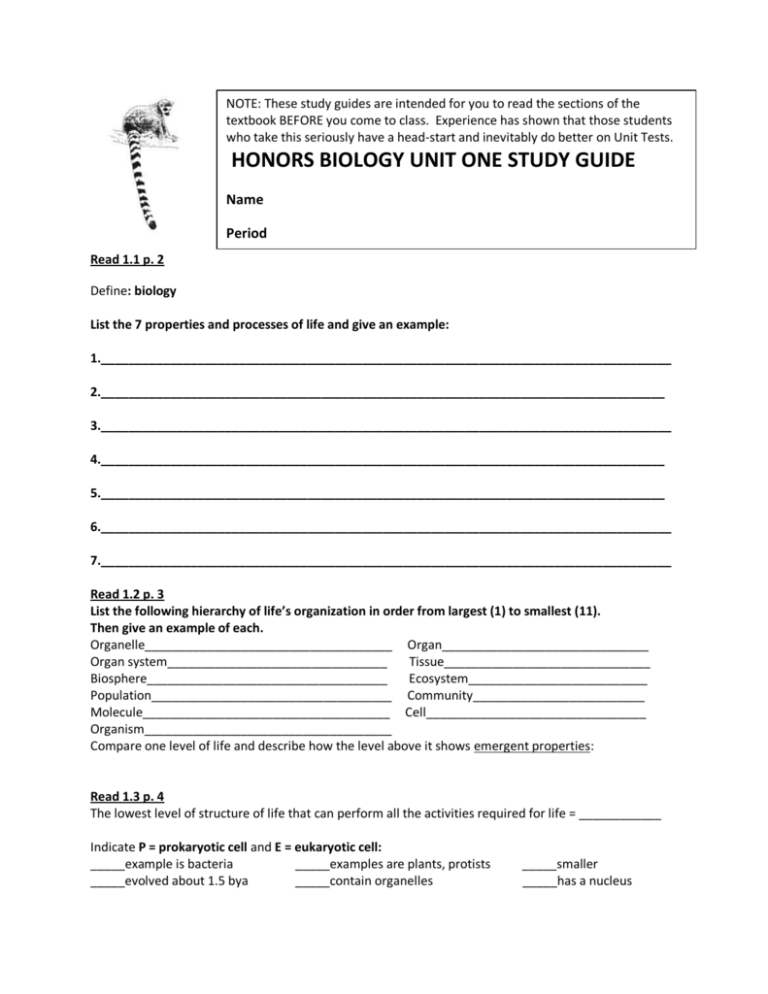HONORS BIOLOGY UNIT ONE STUDY GUIDE
advertisement

NOTE: These study guides are intended for you to read the sections of the textbook BEFORE you come to class. Experience has shown that those students who take this seriously have a head-start and inevitably do better on Unit Tests. HONORS BIOLOGY UNIT ONE STUDY GUIDE Name Period Read 1.1 p. 2 Define: biology List the 7 properties and processes of life and give an example: 1.___________________________________________________________________________________ 2.__________________________________________________________________________________ 3.___________________________________________________________________________________ 4.__________________________________________________________________________________ 5.__________________________________________________________________________________ 6.___________________________________________________________________________________ 7.___________________________________________________________________________________ Read 1.2 p. 3 List the following hierarchy of life’s organization in order from largest (1) to smallest (11). Then give an example of each. Organelle____________________________________ Organ______________________________ Organ system________________________________ Tissue______________________________ Biosphere___________________________________ Ecosystem__________________________ Population___________________________________ Community_________________________ Molecule____________________________________ Cell________________________________ Organism____________________________________ Compare one level of life and describe how the level above it shows emergent properties: Read 1.3 p. 4 The lowest level of structure of life that can perform all the activities required for life = ____________ Indicate P = prokaryotic cell and E = eukaryotic cell: _____example is bacteria _____examples are plants, protists _____evolved about 1.5 bya _____contain organelles _____smaller _____has a nucleus Honors Biology Unit One Study Guide p. 2 Read 1.4 p. 5 Explain how each of these pairs of terms shows interaction of organisms with their environment: a. Producers and consumers b. Consumers and decomposers Read 1.5 p. 6 There is a universal genetic material. What is this molecule called (give 3 letters)?___________ MATCH THESE TERMS: _____units of inheritance _____long molecules of DNA _____building blocks of DNA A. chromosomes B. genes C. nucleotides Why can we use bacterial DNA to make human DNA? Read 1.6 pp. 6-7 and pp. 308-9 Biologists have named about how many species? _______million What is the branch of biology that names and classifies species?____________________________ Who devised this system?___________________________________(see pp. 308-9) What is phylogeny? What makes up the two word names of binomial nomenclature?________________________________ What rules are used to write the scientific names correctly? (at least 3) Put these classification divisions in order from largest to smallest: Genus kingdom family phylum class species order _____________________________________________________________________________________ Fill in the following chart of the three domains: (also pp. 326-327 ) and (Barron’s book pp. 216-219) Archaea Eubacteria Eukarya Prokaryote or Eukaryote? Cell Wall Composition Examples Honors Biology Unit 1 Study Guide p. 3 Read 1.7 pp. 8-9 Fill in the missing words: -Darwin wrote the book____________________________________________________ used to explain his idea of evolution. -His idea was that the mechanism for evolution was __________________ ______________________. -Darwin’s idea that descendants (living today) of ancestral species formed by _________________ with ____________________________. -List at least two adaptations to each of these organisms: GROUND PANGOLIN KILLER WHALE Read 1.8 p. 9 Go back to page 1 and make 3 quantitative observations of the picture of the lemurs. Now make 3 qualitative observations: Label the following as D = deductive or I = inductive reasoning: _____logic from general to specific _____specific observations to generalizations _____”Animals are made of cells, and plants are made of cells, so all organisms are made of cells.” _____If all organisms are made of cells, then bacteria and fungi are made of cells. How is a theory different than a hypothesis? Read 1.9 pp. 10-11 What two point must be followed to be a hypothesis?_________________________________________ In the mimicry experiment with snakes identify the following: Prediction:____________________________________________________________________________ Experimental group:____________________________________________________________________ Control group:________________________________________________________________________ Did the data agree or disagree with the prediction?___________________________________________ Why was there a control group?__________________________________________________________ Read 1.10-11 page 12 Identify as S = science and T = technology: _____discovered the structure of DNA _____invented the PCR to make copies of DNA for forensics _____should we clone humans? _____carbon can bond to four other atoms COPY THE CONCEPT MAP ON PAGE 13 ON ANOTHER PAPER AND FILL IN THE MISSING PARTS: Honors Biology Unit One Study Guide p. 4 Read Barron’s Chapter 17 pp. 387-394 and the Campbell Textbook Chapter 35 pp. 698-719 to match the following terms to their descriptions: 1._____ducklings bond during a critical period A. migration 2._____agressive behavior B. altruism 3._____trial and error learning (+/- effect) C. territoriality 4._____environmental cues that cause a response D. monogamous 5._____defending the area in which you live E. foraging 6._____modification of behavior due to experiences F. cognitive map 7._____come to ignore the repeated stimulus G. behavior 8._____an unchangeable series of actions by a specific response H. dominance hierarchies 9._____behavior under genetic control I. kin selection 10._____food-obtaining behavior J. optimal foraging theory 11._____apply past experiences to novel situations K. social learning 12._____sacrifice itself for the family L. promiscuous 13._____memories of landmarks M. cooperation 14._____no strong pair-bonds N. imprinting 15._____feeding behavior for maximum energy gain O. problem solving 16._____pecking order P. innate behavior 17._____working as a group Q. spatial learning 18._____random movement in response to stimulus R. associative learning (repeat/avoid) 19._____response directed to or away from stimulus S. agnostic behavior 20._____ bond between only one male and one female T. habituation 21._____ regular back-and-forth movement between two U learning geographic areas V. FAP’s 22. _____observing the behavior of others (birds, monkeys) W. taxis 23._____internal representation, code, of surroundings’ objects X. stimuli 24._____an action carried out by muscles or glands under the Y. kinesis control of the nervous system to response to an environmental cue 25._____helping close relatives (share genes with) Write the behavior for each example below: a. _____________________Lorenz’s goslings followed him just after they hatched b. _____________________digger wasp flies to the pinecone circle even if they are moved c. _____________________vervet monkeys give alarm calls when predators appear d. _____________________a chimp learns how to crush a nut with a rock from watching others e. _____________________honeybees dance to show the location of the food source f. _____________________a goose uses its bill to bring an egg back to the nest in the same way each time g. ____________________the alpha hen is the first to the water, food, and roosting sites h. ____________________non-reproductive naked mole may sacrifice himself to the snake to save the queen mole











